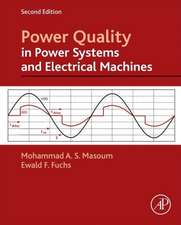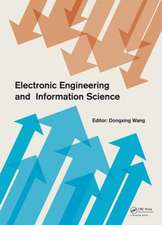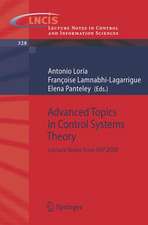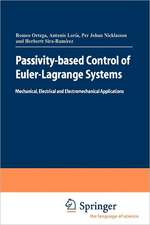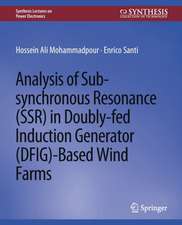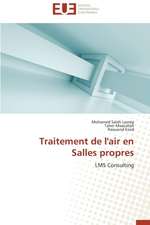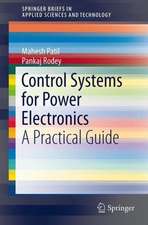Control of Robot Manipulators in Joint Space: Advanced Textbooks in Control and Signal Processing
Autor Rafael Kelly, Victor Santibáñez Davila, Julio Antonio Loría Perezen Limba Engleză Paperback – 27 iun 2005
In addition to the written text, auxiliary resources are available in the form of pdf projector presentations for the instructor to use in lectures and as printed class aids for students, and a pdf solutions manual.
Din seria Advanced Textbooks in Control and Signal Processing
- 17%
 Preț: 460.72 lei
Preț: 460.72 lei - 15%
 Preț: 659.35 lei
Preț: 659.35 lei -
 Preț: 375.68 lei
Preț: 375.68 lei - 15%
 Preț: 593.42 lei
Preț: 593.42 lei - 15%
 Preț: 616.31 lei
Preț: 616.31 lei - 18%
 Preț: 991.55 lei
Preț: 991.55 lei - 20%
 Preț: 572.72 lei
Preț: 572.72 lei - 15%
 Preț: 502.22 lei
Preț: 502.22 lei -
 Preț: 393.90 lei
Preț: 393.90 lei - 15%
 Preț: 499.26 lei
Preț: 499.26 lei -
 Preț: 394.29 lei
Preț: 394.29 lei - 15%
 Preț: 582.30 lei
Preț: 582.30 lei -
 Preț: 358.79 lei
Preț: 358.79 lei - 15%
 Preț: 652.49 lei
Preț: 652.49 lei -
 Preț: 396.02 lei
Preț: 396.02 lei -
 Preț: 396.40 lei
Preț: 396.40 lei - 15%
 Preț: 505.83 lei
Preț: 505.83 lei - 19%
 Preț: 564.48 lei
Preț: 564.48 lei - 20%
 Preț: 333.72 lei
Preț: 333.72 lei -
 Preț: 402.00 lei
Preț: 402.00 lei - 15%
 Preț: 502.22 lei
Preț: 502.22 lei - 15%
 Preț: 658.05 lei
Preț: 658.05 lei - 15%
 Preț: 592.95 lei
Preț: 592.95 lei -
 Preț: 392.75 lei
Preț: 392.75 lei - 23%
 Preț: 669.20 lei
Preț: 669.20 lei - 19%
 Preț: 475.27 lei
Preț: 475.27 lei - 19%
 Preț: 531.49 lei
Preț: 531.49 lei - 19%
 Preț: 535.15 lei
Preț: 535.15 lei - 15%
 Preț: 711.40 lei
Preț: 711.40 lei - 15%
 Preț: 474.82 lei
Preț: 474.82 lei -
 Preț: 390.46 lei
Preț: 390.46 lei -
 Preț: 391.99 lei
Preț: 391.99 lei - 15%
 Preț: 532.05 lei
Preț: 532.05 lei - 15%
 Preț: 506.48 lei
Preț: 506.48 lei - 21%
 Preț: 467.48 lei
Preț: 467.48 lei
Preț: 597.01 lei
Preț vechi: 702.37 lei
-15% Nou
Puncte Express: 896
Preț estimativ în valută:
114.25€ • 124.06$ • 95.97£
114.25€ • 124.06$ • 95.97£
Carte tipărită la comandă
Livrare economică 22 aprilie-06 mai
Preluare comenzi: 021 569.72.76
Specificații
ISBN-13: 9781852339944
ISBN-10: 1852339942
Pagini: 456
Ilustrații: XXVI, 426 p. 110 illus. With online files/update.
Dimensiuni: 155 x 235 x 28 mm
Greutate: 0.78 kg
Ediția:2005
Editura: SPRINGER LONDON
Colecția Springer
Seria Advanced Textbooks in Control and Signal Processing
Locul publicării:London, United Kingdom
ISBN-10: 1852339942
Pagini: 456
Ilustrații: XXVI, 426 p. 110 illus. With online files/update.
Dimensiuni: 155 x 235 x 28 mm
Greutate: 0.78 kg
Ediția:2005
Editura: SPRINGER LONDON
Colecția Springer
Seria Advanced Textbooks in Control and Signal Processing
Locul publicării:London, United Kingdom
Public țintă
GraduateCuprins
Preliminaries.- to Part I.- What Does “Control of Robots” Involve?.- Mathematical Preliminaries.- Robot Dynamics.- Properties of the Dynamic Model.- Case Study: The Pelican Prototype Robot.- Position Control.- to Part II.- Proportional Control plus Velocity Feedback and PD Control.- PD Control with Gravity Compensation.- PD Control with Desired Gravity Compensation.- PID Control.- Motion Control.- to Part III.- Computed-torque Control and Computed-torque+ Control.- PD+ Control and PD Control with Compensation.- Feedforward Control and PD Control plus Feedforward.- Advanced Topics.- to Part IV.- P“D” Control with Gravity Compensation and P“D” Control with Desired Gravity Compensation.- to Adaptive Robot Control.- PD Control with Adaptive Desired Gravity Compensation.- PD Control with Adaptive Compensation.
Notă biografică
Rafael Kelly has occupied teaching positions at National University of Mexico (UNAM)m University of Nuevo León, ITESM, and CICESE Research Center. He has been visiting Professor at the University of Illinois at Urbana-Champaign and INRIA, France. He is the author of more than 130 papers in refereed journals and conference proceedings, most of them devoted to robot control. Professor Kelly is the recipient of many awards and honours among which is the national award of the Mexican Academy of Sciences. He has taught robot control once a year since 1989.
Victor Santibañez spent several years at the Hot Roller Mill Department of Altos Hornos de México, at the Electronics Instrumentation Department of of Metalúrgica Mexicana Peñoles and the Instituto de Automática Industrial del Consejo Superior de Investigación Científica in Madrid. He has taught robot control and adaptive control twice each year at ITL Mexico since 1997. He is also author of about fifty journal and conference papers as well as a book chapter in adaptive control of manipulators.
Antonio Loría has been a research fellow at the University of Twente, NTNU Norway and UCSB, California. Currently, he has a tenure position as Associate Researcher with the National Centre for Scientific Research (CNRS), France. He is author of more than seventy scientific journal and conference papers as well as four book chapters in control theory; of these publications, more than 20 are on robot control. He is co-author of Passivity-based Control of Euler-Lagrange Systems: Mechanical, Electrical and Electromechanical Applications by R. Ortega, A. Loria, P.J. Nicklasson and H. Sira-Ramirez (1-85233-016-3).
Victor Santibañez spent several years at the Hot Roller Mill Department of Altos Hornos de México, at the Electronics Instrumentation Department of of Metalúrgica Mexicana Peñoles and the Instituto de Automática Industrial del Consejo Superior de Investigación Científica in Madrid. He has taught robot control and adaptive control twice each year at ITL Mexico since 1997. He is also author of about fifty journal and conference papers as well as a book chapter in adaptive control of manipulators.
Antonio Loría has been a research fellow at the University of Twente, NTNU Norway and UCSB, California. Currently, he has a tenure position as Associate Researcher with the National Centre for Scientific Research (CNRS), France. He is author of more than seventy scientific journal and conference papers as well as four book chapters in control theory; of these publications, more than 20 are on robot control. He is co-author of Passivity-based Control of Euler-Lagrange Systems: Mechanical, Electrical and Electromechanical Applications by R. Ortega, A. Loria, P.J. Nicklasson and H. Sira-Ramirez (1-85233-016-3).
Textul de pe ultima copertă
Robot control is the backbone of robotics, an essential discipline in the maintenance of high quality and productivity in modern industry. The most common method of control for industrial robotic manipulators relies on the measurement and amendment of joint displacement: so-called "joint-space control".
Control of Robot Manipulators in Joint Space addresses robot control in depth, treating a range of model-based controllers in detail: proportional derivative; proportional integral derivative; computed torque and some adaptive variants. Using varying combinations of the text’s four parts:
• robot dynamics and mathematical preliminaries;
• set-point model-based control;
• tracking model-based control; and
• adaptive and velocity-independent control
a complete course in robot control based on joint space can be constructed for senior undergraduates or masters students. Other areas of study important to robotics, such as kinematics, receive attention within the case studies which are based around a 2-degrees-of-freedom planar articulated arm termed the Pelican prototype and used throughout to test the examined controllers by experimentation.
In addition to the written text, auxiliary resources are available in the form of pdf projector presentations for the instructor to use in lectures and as printed class aids for students, and a pdf solutions manual. All of this labour-saving supplementary material can be downloaded from springeronline.com.
Control of Robot Manipulators in Joint Space addresses robot control in depth, treating a range of model-based controllers in detail: proportional derivative; proportional integral derivative; computed torque and some adaptive variants. Using varying combinations of the text’s four parts:
• robot dynamics and mathematical preliminaries;
• set-point model-based control;
• tracking model-based control; and
• adaptive and velocity-independent control
a complete course in robot control based on joint space can be constructed for senior undergraduates or masters students. Other areas of study important to robotics, such as kinematics, receive attention within the case studies which are based around a 2-degrees-of-freedom planar articulated arm termed the Pelican prototype and used throughout to test the examined controllers by experimentation.
In addition to the written text, auxiliary resources are available in the form of pdf projector presentations for the instructor to use in lectures and as printed class aids for students, and a pdf solutions manual. All of this labour-saving supplementary material can be downloaded from springeronline.com.
Caracteristici
Tutors can design entry-level courses in robotics with a strong orientation to the fundamental discipline of manipulator control pdf solutions manual Overheads will save a great deal of time with class preparation and will give students a low-effort basis for more detailed class notes Courses for senior undergraduates can be designed around Parts I – III; these can be augmented for masters courses using Part IV Includes supplementary material: sn.pub/extras Request lecturer material: sn.pub/lecturer-material

